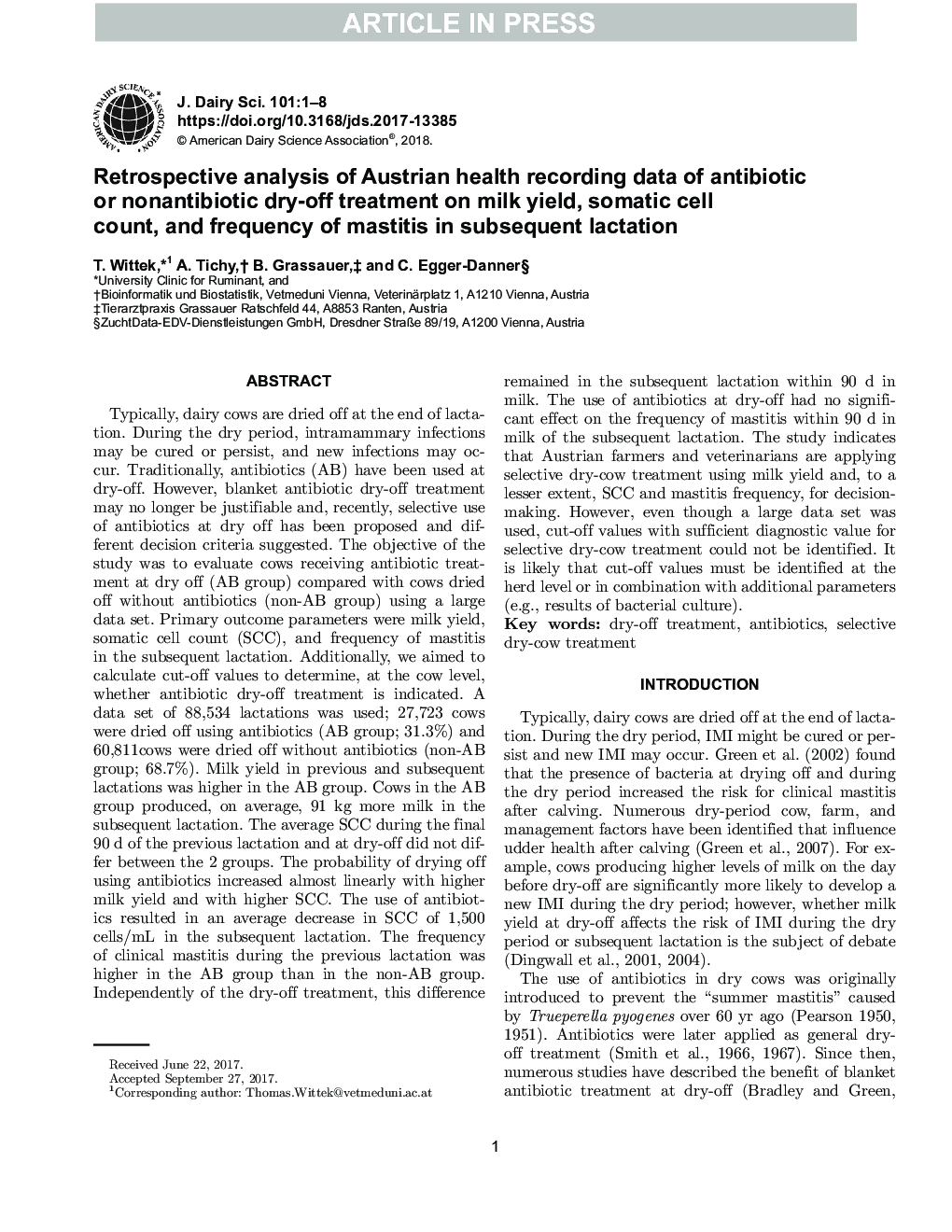| کد مقاله | کد نشریه | سال انتشار | مقاله انگلیسی | نسخه تمام متن |
|---|---|---|---|---|
| 8501663 | 1553843 | 2018 | 8 صفحه PDF | دانلود رایگان |
عنوان انگلیسی مقاله ISI
Retrospective analysis of Austrian health recording data of antibiotic or nonantibiotic dry-off treatment on milk yield, somatic cell count, and frequency of mastitis in subsequent lactation
ترجمه فارسی عنوان
تجزیه و تحلیل تجربی از داده های ضبط سلامت اتریش از درمان خشکی با آنتی بیوتیک یا غیر انتبیوتیک بر عملکرد شیر، تعداد سلول های سوماتیکی و فرکانس ماستیت در شیردهی بعد
دانلود مقاله + سفارش ترجمه
دانلود مقاله ISI انگلیسی
رایگان برای ایرانیان
کلمات کلیدی
خشک کردن درمان، آنتی بیوتیک ها، انتخاب گاو خشک گاو،
موضوعات مرتبط
علوم زیستی و بیوفناوری
علوم کشاورزی و بیولوژیک
علوم دامی و جانورشناسی
چکیده انگلیسی
Typically, dairy cows are dried off at the end of lactation. During the dry period, intramammary infections may be cured or persist, and new infections may occur. Traditionally, antibiotics (AB) have been used at dry-off. However, blanket antibiotic dry-off treatment may no longer be justifiable and, recently, selective use of antibiotics at dry off has been proposed and different decision criteria suggested. The objective of the study was to evaluate cows receiving antibiotic treatment at dry off (AB group) compared with cows dried off without antibiotics (non-AB group) using a large data set. Primary outcome parameters were milk yield, somatic cell count (SCC), and frequency of mastitis in the subsequent lactation. Additionally, we aimed to calculate cut-off values to determine, at the cow level, whether antibiotic dry-off treatment is indicated. A data set of 88,534 lactations was used; 27,723 cows were dried off using antibiotics (AB group; 31.3%) and 60,811cows were dried off without antibiotics (non-AB group; 68.7%). Milk yield in previous and subsequent lactations was higher in the AB group. Cows in the AB group produced, on average, 91 kg more milk in the subsequent lactation. The average SCC during the final 90 d of the previous lactation and at dry-off did not differ between the 2 groups. The probability of drying off using antibiotics increased almost linearly with higher milk yield and with higher SCC. The use of antibiotics resulted in an average decrease in SCC of 1,500 cells/mL in the subsequent lactation. The frequency of clinical mastitis during the previous lactation was higher in the AB group than in the non-AB group. Independently of the dry-off treatment, this difference remained in the subsequent lactation within 90 d in milk. The use of antibiotics at dry-off had no significant effect on the frequency of mastitis within 90 d in milk of the subsequent lactation. The study indicates that Austrian farmers and veterinarians are applying selective dry-cow treatment using milk yield and, to a lesser extent, SCC and mastitis frequency, for decision-making. However, even though a large data set was used, cut-off values with sufficient diagnostic value for selective dry-cow treatment could not be identified. It is likely that cut-off values must be identified at the herd level or in combination with additional parameters (e.g., results of bacterial culture).
ناشر
Database: Elsevier - ScienceDirect (ساینس دایرکت)
Journal: Journal of Dairy Science - Volume 101, Issue 2, February 2018, Pages 1456-1463
Journal: Journal of Dairy Science - Volume 101, Issue 2, February 2018, Pages 1456-1463
نویسندگان
T. Wittek, A. Tichy, B. Grassauer, C. Egger-Danner,
